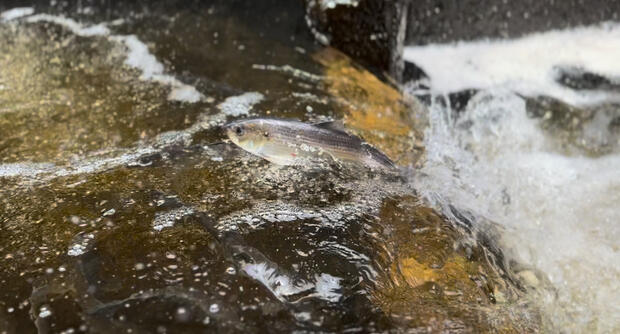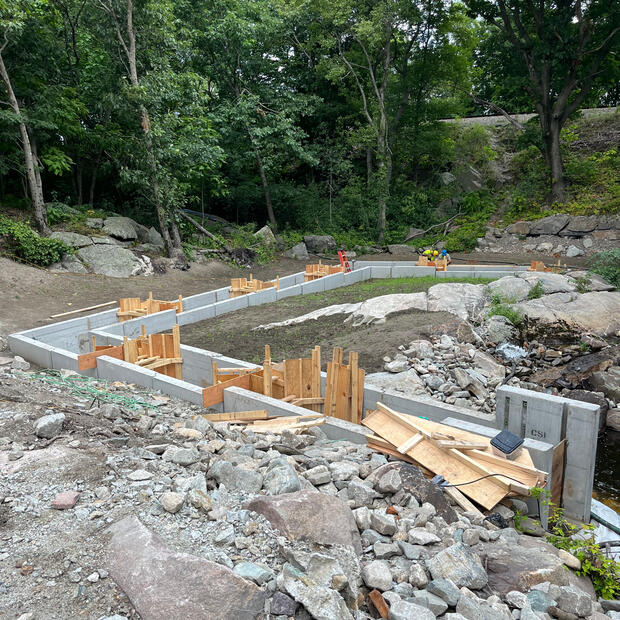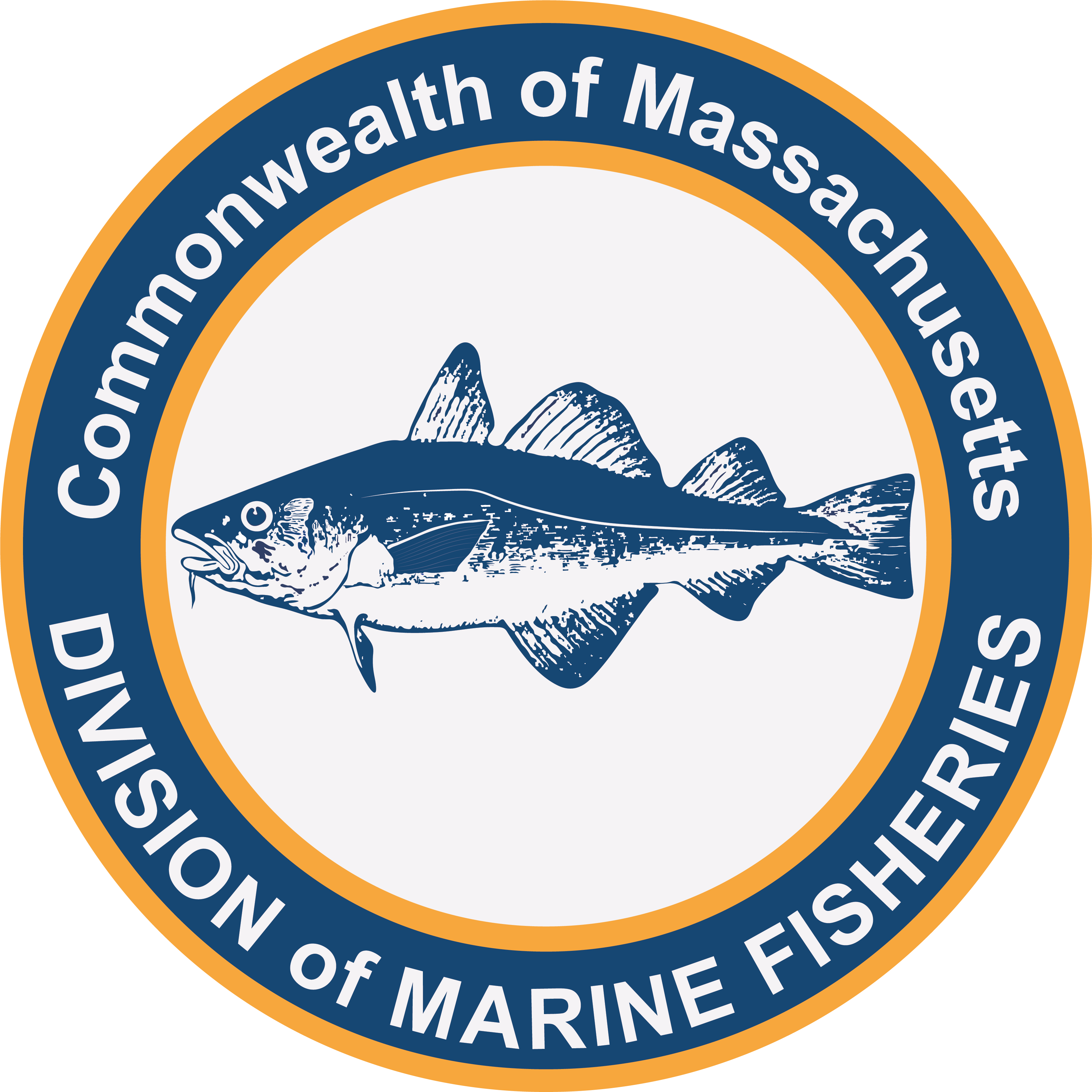- Division of Marine Fisheries
Diadromous, or sea-run fish, are the migratory fish that switch between marine and freshwater habitats to complete their life history. Most diadromous fish populations have declined sharply from historical periods when valuable fisheries were supported. Presently, minor fisheries occur for a few diadromous species and collectively these fish remain important forage for a wide range of fish and wildlife. The DMF Diadromous Fisheries Project actively monitors river herring, American shad, American eel, and rainbow smelt spawning runs in coastal rivers to contribute to population assessment and management of these species and to inform restoration planning.
River Herring Counts
About 45 Massachusetts coastal rivers are monitored each spring for river herring passage. While most of these are visual counts led by local watershed groups (with run size extrapolations generated by DMF staff), there is a growing number of higher technology counts occurring here now with 12 electronic and 9 video counting stations active in 2024 (see accompanying article “DMF Diadromous Project Looks to Future Technologies for Monitoring Fish Populations”). With sufficient duration and data quality, these herring counts can contribute to coastwide stock assessments and local harvest management.
The most recent such coastwide stock assessment for river herring was completed in 2024, finding the overall resource for the East Coast to be depleted from historical levels with most indices of abundance not showing significant trends since the reference year of 2009. From 29 river herring counts in Massachusetts considered in the assessment, six “sentinel” counts (Nemasket, Monument, Town, Back, Mystic, and Parker rivers) were included as sites with suitable spawning run counts and biological data on size and age. The trends for these sentinel sites were largely neutral since 2009. The assessment also accepted five new stations as spawning run count indices of abundance (Mattapoisett, Agawam, Wankinco, Stony Brook and Herring River in Wellfleet). This is a welcome contribution to the assessment of a data-poor species and a credit to all those that participate in those counts.
The river herring count status in recent years has shown some volatility with some larger runs North of Cape Cod trending up and some smaller runs from Cape Cod west showing persistent low numbers. DMF implemented a river herring harvest ban in 2006 out of concern for uniformly declining runs following a series of droughts. Most coastal regions experienced improving spawning run counts soon after with increases during 2012–2019; however, during 2020–2022, declines and instability were seen in counts at many coastal rivers. The regional trend mentioned above was again apparent in 2023, with numbers up at many locations including five rivers with time series highs. The top three count stations in 2023 were repeated in 2024 at the Herring Brook, Pembroke (444,000); Herring River, Harwich (451,000); and the Mystic River, Medford (650,000). The Mystic River has come on strong in the last decade following fishway installations—it has now had the highest count among all stations during three of the last eight years. Congratulations to all the agency and local crews that have made the restoration effort in the Mystic River a large success.
The influence of droughts and low stream flow on the summer and fall juvenile river herring emigration to marine waters remains a significant concern in coastal Massachusetts. Several significant droughts have impacted coastal Massachusetts since 2016. The count records suggest that the serious drought of 2016 did not cause widespread reductions in returning adults. The jury is still out on the impact of the 2020 drought. This spring had elevated stream flows only to suffer from low rainfall during summer and fall that brought much of the state to a drought status. Nearly all USGS streamflow gauge stations were below their 25th percentile for the month of November. Stream flows remain low in many places even in early December. DMF staff was active this fall visiting sites with low stream flow to remove debris, treefalls, sand berms and leaf jams that can threaten juvenile herring emigration during reduced flows.
Stocking
DMF maintains a stocking truck capable of moving 2,000 herring and two portable tank systems for moving up to 250 herring. In 2024, herring were stocked at five locations related to recent or ongoing fish passage restoration efforts: Island Creek, Duxbury; Bourne Pond, Falmouth; Sandy Bottom Pond, Yarmouth; Tom Matthews Pond, Yarmouth; and Mill Pond, Barnstable. DMF also has an agreement with the USFWS to stock larval American shad in the Taunton River. This cooperative effort with the Division of Fish and Wildlife seeks to restore a recreational fishery for shad in the Taunton River by stocking three million shad larvae annually for five years. The project is off to a good start with over five million fish stocked each year from 2022 to 2024.
Fish Passage Restoration
Every year, numerous fish passage restoration projects are in development both by DMF and cooperatively under local, State and Federal partnerships. Project development in 2024 was higher than typical with many projects supported by federal infrastructure stimulus funding. This article does not have space to report on the large number of fish passage projects advancing through design stages presently. Instead, we will highlight several that were under construction in 2024 and annual efforts by the DMF Fishway Crew.
- South River, Marshfield. Construction is underway at the Veterans Memorial Park on the South River in Marshfield to replace an existing dam and fishway with a nature-like fishway and include park features such as a lagoon and water wheel. This project, led by the Town of Marshfield, has the unusual promise of benefiting at least six species of diadromous fish including one of the few small-river American shad runs in coastal Massachusetts.
- Sesuit Creek, Dennis. The Massachusetts Department of Transportation is replacing two culverts on Route 6A in Dennis to improve fish passage from Sesuit Creek to Scargo Lake. DMF identified that the undersized culverts and associated riprap blockages was causing significant fish passage and mortality impacts, and recognizing the need to also improve the roadway infrastructure itself, MassDOT fully funded the culvert replacement.
- Stony Brook, Brewster. The Town of Brewster is working with the National Resources Conservation Services and Cape Cod Conservation District to rebuild the fishway at Stony Brook. This iconic mill site is one of the most visited “herring parks” in Massachusetts, with generations of families holding fond memories of seeing herring at Stony Brook. The degree of difficulty, historic mill site, and large Cape Cod Bay herring run make this a regional priority for fish passage improvements.
- Fore River Watershed, Braintree. The long-running restoration effort to open passage for diadromous fish in the Fore River watershed was completed in 2024. Obstructions at four locations blocked river herring and other species from reaching over 200 acres of spawning and nursery habitat for over 200 years. The final step was the construction of a fishway at the Rock Falls in 2024. This followed the removal of the Armstrong Dam upstream of the falls in 2023. These two projects had held the regional ranks of first and second in the DMF Diadromous Fish Restoration Priority List in recent years. This milestone has come following years of dedicated efforts from the Town of Braintree and project partners. With the completion of two dam removals and two fishways, there will be much excitement to see how fish respond during the spring 2025 migration. And with these high-ranking projects done and off the list, these collective efforts can now focus on the next challenging projects waiting for their turn.
- DMF Fishway Crew. The Fishway Crew had a solid 2024 season of repairing fishways with six jobs completed. Four jobs (Parker River, Newbury; Acushnet River, Acushnet; Depot Pond, Eastham; and Herring Creek, Aquinnah) were small physical repairs with minor costs. In each case, the time spend on travel, shop fabrication, and authorizations far exceeded the half day of field repairs. In addition, repairs continued at the Army Corps’ fishway on the Cape Cod Canal. Concrete fishway weirs along the canal were built in the 1930s and are showing their age. The Fishway Crew reformed one of the weirs this past summer with plans to finish all replacements by 2026. The largest fishway job of the year was at Wings Pond in Falmouth, where 10 in-stream concrete weirs constructed by DMF in 1975 in cooperation with the cranberry bog owner and Town of Falmouth were showing their age. The stream flow had eroded the banks around several of the upper weirs and sea-level rise and foot traffic had eroded the banks around the lower weirs, causing improper functioning. With the same cooperative partners, the Crew spent two weeks to remove four of the weirs, reform one concrete weir, and repair the channel and bank at three weirs with rock weirs and fiber rolls. This project was a good example of blending DMF’s capacity with fabrication, field equipment and hard labor to complete challenging repairs at low cost.
By Brad Chase, Diadromous Fisheries Project Leader
NOTICE
DMF will host a river herring counting workshop on March 12, 2025 at our New Bedford laboratory. The workshop follows a DMF workshop held 20 years ago in Gloucester that ushered the modern effort to count river herring in Massachusetts during their spring spawning migrations. The 2025 workshop will focus on updates and lessons-learned on volunteer visual count, electronic, and video counting methods. Stay tuned for a formal notice and agenda.


